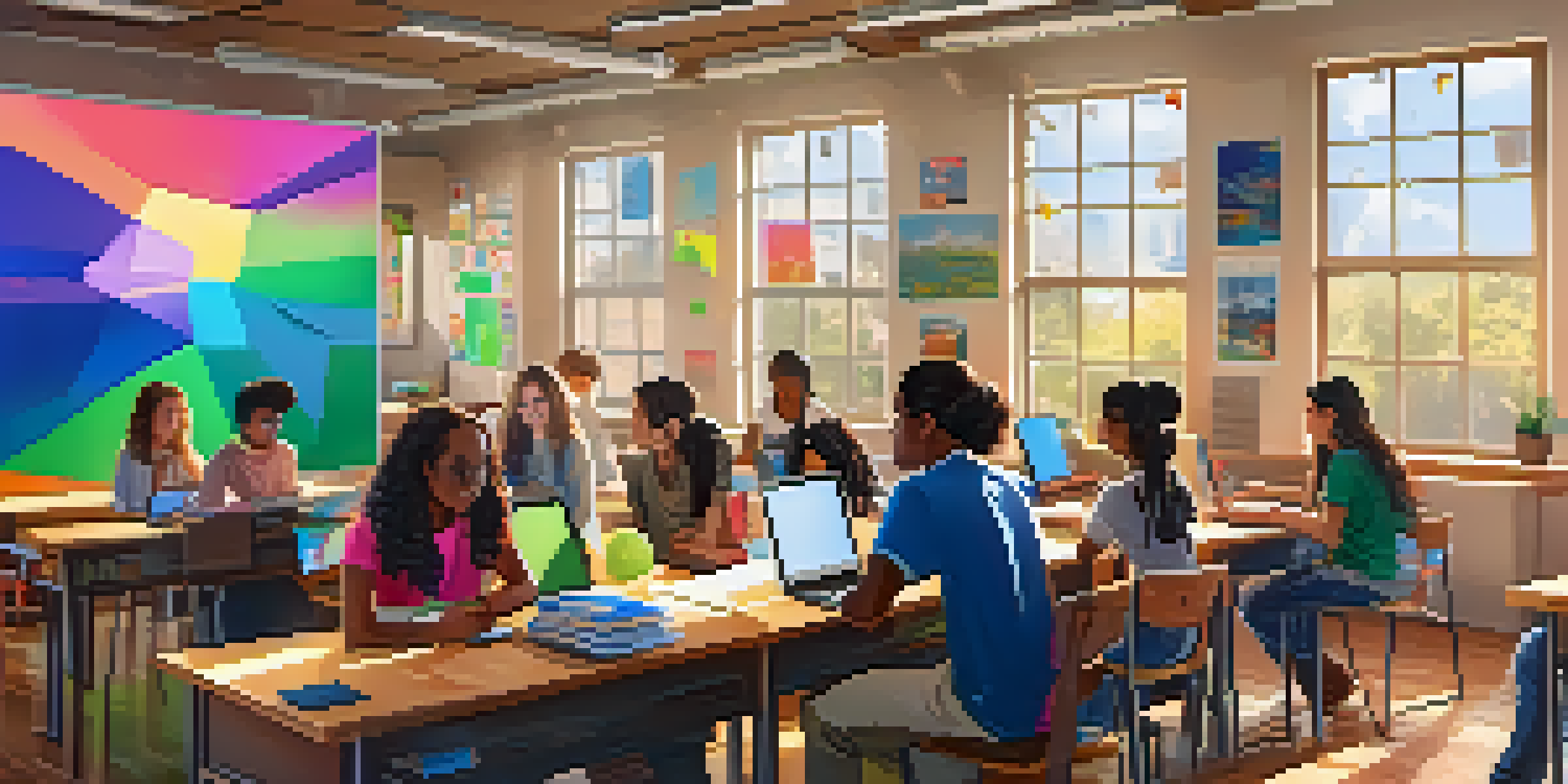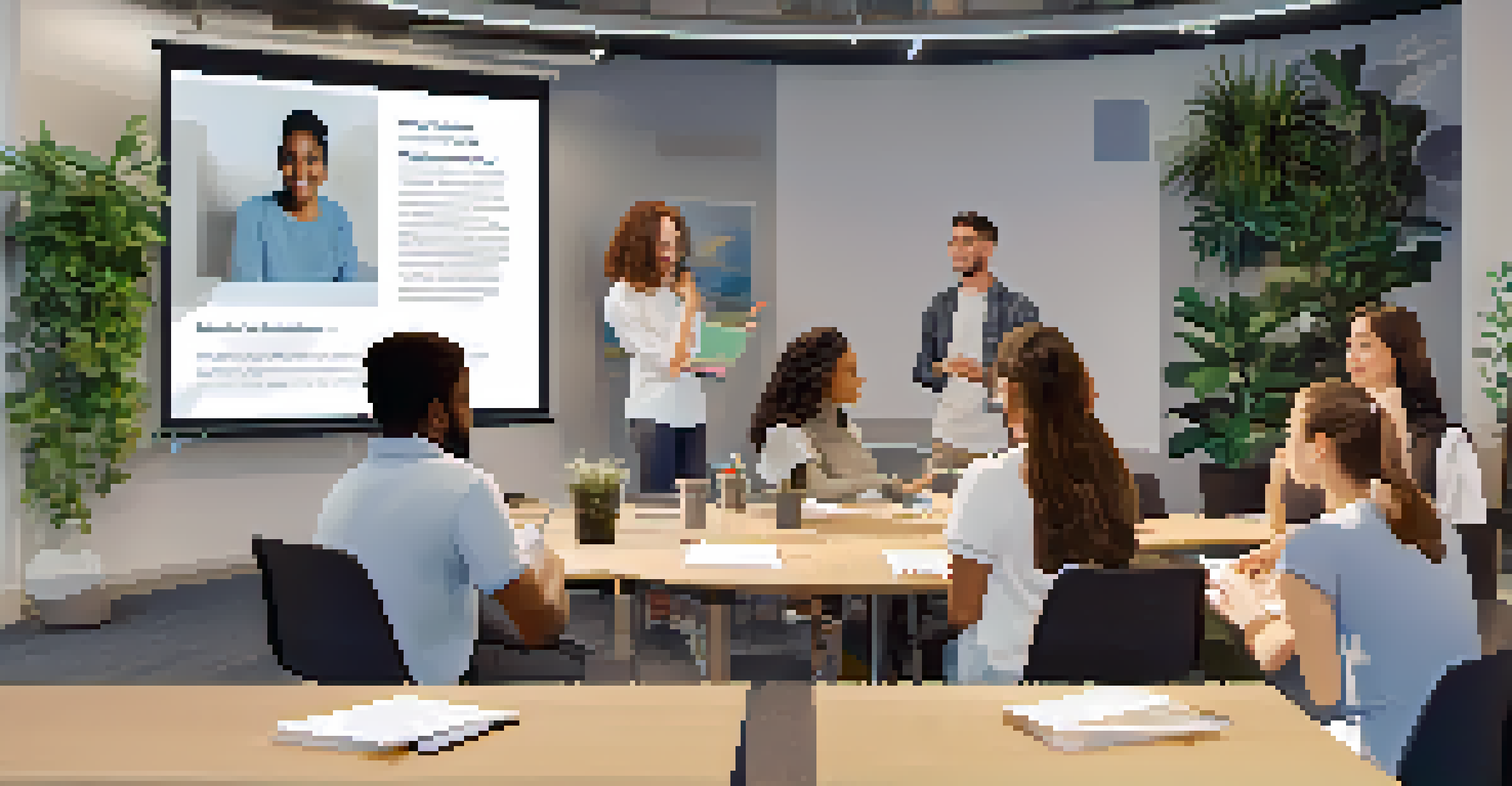Implementing Project-Based Learning in Digital Spaces

Understanding Project-Based Learning in Digital Contexts
Project-based learning (PBL) is an instructional approach that encourages students to engage in real-world projects. In digital spaces, this method takes on a unique flavor, allowing for collaboration and creativity through online platforms. By using technology, educators can create immersive experiences that promote critical thinking and problem-solving skills.
Project-based learning is a way to make learning relevant and engaging, allowing students to take ownership of their education.
Digital tools like Google Classroom, Zoom, and collaborative software facilitate communication and teamwork among students, making PBL more accessible. For example, students can work together on a shared document, brainstorming ideas and providing feedback in real-time. This not only enhances the learning experience but also prepares them for future work environments where collaboration is key.
Moreover, PBL in digital settings can cater to diverse learning styles, ensuring that all students can engage meaningfully. Whether through videos, interactive forums, or virtual presentations, the flexibility of digital spaces allows for a richer educational experience. This adaptability is crucial, especially in today's fast-paced, technology-driven world.
Key Benefits of PBL in Online Learning Environments
One of the most significant benefits of project-based learning online is the development of essential skills. Students learn to manage their time, communicate effectively, and collaborate with peers, which are vital in both academic and professional settings. For instance, working on a group project about climate change can help students not only understand the topic but also hone their research and presentation skills.

Additionally, PBL fosters a sense of ownership and motivation among students. When learners are involved in projects that interest them, they are more likely to stay engaged and committed. This intrinsic motivation can lead to deeper understanding and retention of knowledge, as students are not just memorizing facts but applying what they learn in practical situations.
Benefits of Digital PBL
Project-based learning in digital environments enhances essential skills like collaboration, creativity, and intrinsic motivation among students.
Finally, PBL encourages creativity and innovation, which are essential in today’s job market. By allowing students to explore their ideas in a supportive environment, educators can cultivate a generation of thinkers who are not afraid to challenge the status quo. This creative freedom is often more pronounced in digital spaces, where resources and inspiration are just a click away.
Tips for Designing Engaging PBL Experiences Online
Designing effective project-based learning experiences in digital spaces starts with choosing relevant, real-world problems. Educators should select topics that resonate with students' interests and experiences, making the work feel meaningful. For example, if students are passionate about animal welfare, a project centered around local wildlife conservation could spark their engagement.
The future of education is not in the classroom, but in the world of digital learning, where collaboration knows no bounds.
Incorporating various digital tools can enhance the learning experience significantly. Platforms like Padlet for brainstorming or Trello for project management can help students organize their thoughts and tasks effectively. By utilizing a mix of resources, educators can cater to different learning styles and preferences, ensuring that every student finds a way to contribute.
Lastly, providing clear guidelines and expectations is crucial for online PBL. Students should understand the project’s objectives, deadlines, and assessment criteria from the start. This clarity helps to minimize confusion and keeps students focused on their goals, allowing for a smoother collaborative process.
Fostering Collaboration in Digital Project-Based Learning
Collaboration is at the heart of project-based learning, especially in online settings. To create a collaborative environment, educators can encourage group formation based on shared interests or skills. This not only enhances teamwork but also allows students to learn from one another, fostering a sense of community even in a digital landscape.
Using tools like discussion boards or video conferencing can further facilitate collaboration. These platforms provide students with opportunities to share ideas, debate perspectives, and refine their projects together. For instance, a virtual meeting can help a group of students finalize their research approach, making the process more dynamic and interactive.
Designing Engaging PBL
Effective online PBL experiences stem from choosing relevant topics, incorporating diverse tools, and providing clear guidelines.
Moreover, establishing roles within each group can promote accountability and ensure that every student contributes meaningfully. By designating tasks such as researcher, presenter, or editor, students can leverage their strengths while learning to collaborate effectively. This structure helps maintain engagement and encourages students to take ownership of their parts in the project.
Assessment Strategies for PBL in Digital Spaces
Assessing project-based learning can be challenging, especially in an online format. Traditional grading methods may not fully capture the depth of students' learning experiences. Instead, educators can consider using rubrics that evaluate both the final product and the collaborative process involved in creating it.
Peer assessments can also play a crucial role in the evaluation process. Allowing students to give feedback to one another fosters critical thinking and reflection on their work. It encourages them to consider different perspectives and understand the importance of constructive criticism in a collaborative environment.
Additionally, incorporating self-assessment can empower students to take ownership of their learning journey. By reflecting on their contributions and challenges, they can identify areas for improvement, setting personal goals for future projects. This process not only enhances their self-awareness but also encourages lifelong learning habits.
Overcoming Challenges in Online PBL Implementation
While implementing project-based learning in digital spaces offers numerous benefits, it also comes with its challenges. Technical issues, such as connectivity problems or unfamiliarity with tools, can hinder the learning experience. To mitigate this, educators should provide training sessions and resources to help students navigate the digital landscape effectively.
Moreover, maintaining engagement can be difficult in an online environment. Students may feel isolated or distracted, leading to decreased motivation. To combat this, educators can foster a supportive online community by encouraging regular check-ins and providing opportunities for social interaction, such as virtual icebreakers or team-building activities.
Future of PBL in Digital Spaces
As technology advances, virtual reality and AI are set to transform project-based learning by offering immersive experiences and personalized learning paths.
Lastly, differences in students' access to technology can create disparities in participation. Educators must be mindful of these challenges and strive to create inclusive learning experiences. Offering alternative project formats or accommodating different technological capabilities can help ensure that all students have the opportunity to succeed.
Future Trends in Project-Based Learning Online
As technology continues to evolve, so do the possibilities for project-based learning in digital spaces. Emerging tools like virtual and augmented reality are beginning to shape how students engage with projects, making learning experiences even more immersive. Imagine students exploring historical sites or scientific phenomena through virtual reality, bringing subjects to life in ways previously unimaginable.
Artificial intelligence is also poised to play a significant role in customizing learning experiences. By analyzing individual student performance, AI can provide tailored recommendations and resources, ensuring each learner progresses at their own pace. This personalized approach can enhance the effectiveness of PBL, making it more relevant to each student's unique context.

Finally, the global nature of digital learning opens doors for international collaboration. Students can connect with peers from around the world to work on shared projects, gaining diverse perspectives and cultural insights. This not only enriches their learning experience but also prepares them for a globalized workforce, where cross-cultural communication is key.